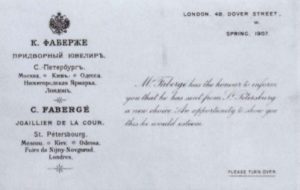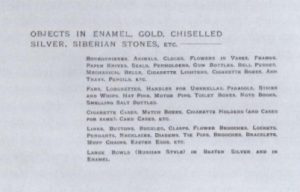There are two sources of information for Queen
Alexandra’s purchases from Fabergé from which it is possible
to build up a picture of her buying habits. These are her
own accounts, a proportion of which survive in the Royal
Archives, and the sales ledgers from the London branch which
are held in the Fabergé Archive in Geneva. Queen Alexandra’s own accounts reveal that between 1902 and 1914 a total
of £3,197 was spent with Fabergé. Of that total £2,614 was
paid from the Queen’s presents account, indicating that many
of the objects were given away rather than kept by her.10
The remaining £583, paid from a ‘miscellaneous’ account,
must relate to objects she kept.
The London ledgers are an invaluable source of information as they indicate the types of objects purchased by
Queen Alexandra as presents. It is reasonable to assume that
any of these objects which do not now form part of the collection were paid for from the presents account. The ledgers
run from October 1907 to January 1917. There are no entries
in the ledgers between October 1906 and October 1907, probably due to reorganisation following the end of Fabergé’s
business arrangement with Allan Bowe. Fabergé was obliged
to close the London branch in 1915 to comply with the imperial order that all capital abroad should be returned to Russia
in order to finance its war effort, but H.C. Bainbridge carried
on the business privately for another two years.
At first there were no import taxes on objects brought
into England by Fabergé and the laws on hallmarking gold
allowed for wide interpretation. Fabergé refused to have his
objects hallmarked in England for technical reasons. As a result

 the Goldsmiths’ Company brought a court case against him
the Goldsmiths’ Company brought a court case against him
in 1910 which took more than a year to settle and which Fabergé
lost. Birbaum describes how, following the case, the process
of sending objects to be sold in the London branch became
complex. Each silver or gold object had to be sent to London
to be hallmarked and then returned to Russia to be finished before being sent back to London to be sold. The reason
for the double journey was that when enamelled objects were
hallmarked, some separation occurred between the enamel
and the metal. It was therefore necessary to carry out finishing back in Russia. According to Birbaum, it was deemed
that this process would lead to losses for the firm; the closure
of the London branch was therefore hastened, rather than initiated, by the First World War.11
Queen Alexandra made the majority of her purchases
at the London branch in the Easter and Christmas seasons,
which underlines the fact that many were intended to be given
away. She purchased most frequently between 1906 and 1911,
the largest number of objects (thirty-three) being bought in
1909. Her acquisitions ranged from animals and cigarette
cases to miniature eggs and frames. She also bought a number of pieces of jewellery, very few of which remain in the
collection. While there is no record of any direct commission,
the special relationship that the Queen had with Bainbridge
must have resulted in some objects being specially designed
for her. One such example is the frog cigar lighter (cat. 82)
which she purchased for King Edward VII in 1906. It is so
much in keeping with his taste that she is likely to have ordered
it specially for him.
The most notable exhibition of Fabergé during the
early years of the twentieth century was held in St Petersburg
in 1902 and included several of the Imperial Easter Eggs,
among other treasures. The only exhibition held during the
same period in England, in fact the first ever to be staged there,
was organised by Lady Paget, wife of General Sir Arthur Paget.
It was held in June 1904 at the Albeit Hall and took the form of a charity bazaar in aid of the Royal Victoria Hospital for
Children. Queen Alexandra gladly lent her support, apparently purchasing a jade scent bottle and an enamel and diamond
cigarette holder, both made by Fabergé.